Post-incident reporting for reservoirs: annual report 2020
Updated 7 October 2024
Applies to England
1. Foreword
We take reservoir safety very seriously. Reservoirs in England have an excellent safety record overall. The last reservoir failure that led to loss of life in England was more than 100 years ago. Climate change and recent flooding and the events demonstrate how crucial it is for all infrastructure to be fit for the future.
Reservoir structures are regulated by the Reservoirs Act 1975, which sets out stringent conditions for the operation of reservoirs to ensure high levels of safety.
The responsibility for ensuring the safety of reservoirs lies with the operators. Our job, as the regulator, is to ensure they comply with the legal safety requirements. We do this by monitoring the compliance at all 2,097 large raised reservoirs (LRRs) in England.
We publish this report so that all those involved in reservoir safety can learn from past incidents. By sharing experiences, we can improve safety for the future. The information provided identifies trends and lessons learnt, which contributes to research into reservoir safety. So, please continue to help by reporting all incidents no matter how small or insignificant they may appear.
I would like to thank everyone in the reservoir sector who has contributed to this report and who continues to support the system we have in place for post-incident reporting. By doing this we are making a very real and tangible contribution to improving reservoir safety.
Antony Deakin, Reservoir Safety Manager, Environment Agency
2. Executive summary
For this report the Environment Agency received final information on 4 incidents that occurred during 2020. Incidents are classified by their level of severity. They are:
- 1 (failure)
- 2 (emergency works)
- 3 (precautionary or unplanned works)
For more details on the classification system see the incident classification levels section. Four incidents occurred in 2020. All 4 were classified as level 3 incidents. The Environment Agency also received final information on 1 incident from 2017 and 4 incidents from 2019.
The 2017 incident was classed as level 3. In 2019, 1 was classed as a level 1 incident and the other 3 were classed as level 3 incidents. The level 1 incident occurred at a small raised reservoir (SRR) (non-statutory). A SRR can hold up to 25,000 m3 of water above ground level.
Final information was received on incident 454 (Toddbrook). This incident was reported in the 2019 Reservoir safety post incident report and therefore is not included here. In 2020, the following reports were published with full information about this incident, its causes and lessons learnt:
- Independent Government Review Report
- Canal and Rivers Trust report
- Environment Agency Lessons Learnt Technical Bulletin
It is not unusual for reports to include information from previous years. This is because reservoir undertakers (the owners and operators of a reservoir) have 12 months to provide a full and comprehensive post incident report. A qualified civil engineer (QCE), appointed by the Secretary of State for Environment, Food and Rural Affairs, reviews all incidents. The incidents in this report are either resolved or have plans in place to address any outstanding issues.
Each case study in the report contains important learning points for each incident. The main learning points are the importance of:
- routine surveillance to detect potential issues
- increasing monitoring during periods of high water levels and when awaiting repairs
- adequate maintenance of structures and pipework
Every 5 years, the Environment Agency reports on detailed statistics of reservoir incidents. Further details can be found in the Analysis of reported incidents section later in this report.
3. Reporting incidents in England
On 31 December 2020, 2,097 reservoirs were classed as statutory large raised reservoirs (LRRs) in England. Since July 2013, undertakers of LRRs in England must report any incidents to the Environment Agency. This is a requirement of the Reservoirs Act 1975 and Regulation 14 of Statutory Instrument 2013 No. 1677. Undertakers of SRRs (non-statutory) can voluntarily report incidents. As soon as an incident is under control, the reservoir undertaker must provide a preliminary report to us. This report must contain:
- the date and time of the incident
- the location of the reservoir
- incident details (observations)
The reservoir undertaker must send the Environment Agency a final post-incident report form within a year of the incident. The report must contain:
- information about the facts relating to it
- analysis of its circumstances
- any conclusions
- any lessons learned from the incident
The Environment Agency reviews the final report. We seek further clarification from the undertaker as necessary. We assign an incident number to each incident when they are reported to us. They are not always in numerical order when they are published. This is because they are not always classed as reportable incidents. In some cases, we wait to report on incidents until the undertaker completes a full investigation of the causes. This reporting process is separate to any incident response.
If you have concerns about the operation of a reservoir you should report it immediately to the:
- Environment Agency on the incident hotline 0800 80 70 60
- emergency services
4. Incident classification levels
The Environment Agency classifies incidents according to the level of severity. There are 3 levels.
Level 1 - this is a failure, which is an uncontrolled sudden large release of retained water.
Level 2 - this is a serious incident involving any of the following:
- an emergency drawdown
- emergency works
- a serious operational failure in an emergency
Level 3 - is any incident involving:
- a precautionary drawdown
- unplanned physical works
- human error leading to a major (adverse) change in operating procedures
All these incident categories are covered by the regulations.
5. Reported incidents overview
This year the Environment Agency received final information for:
- 4 incidents that occurred in 2020
- 4 incidents that occurred in 2019
- 1 incident that occurred in 2017
Eight of these incidents were at LRRs with embankment dams. An embankment dam is a large artificial dam. It is typically created by compaction of soil, sand, clay, or rock. If the main component of the embankment is clay and soil, it is called an ‘earthfill’ embankment. One incident took place at an SRR.
The Environment Agency seeks advice from an independent QCE to classify the incidents. Following this advice, for final information received in 2020 we classed:
- all incident reports in 2020 as level 3
- one incident from 2019 as level 1 (SRR)
- 3 incidents from 2019 as level 3
- 1 incident from 2017 as level 3
The incidents in this report are either resolved or have plans in place to address outstanding issues.
6. 2017 incidents
This section provides details on incidents that occurred in 2017.
6.1 Incident 456
Dam type: earthfill embankment.
Reservoir legal status: statutory (LRR).
Dam height: 10 metres.
Incident type: other.
Incident severity: 3.
The incident occurred at an impounding reservoir. This is where a dam blocks the natural flow of a river or drainage from an area.
A 1.5m diameter culvert passes under the left wall of the dam embankment. There is a 2m diameter access shaft to the culvert which allows access from the dam crest.
During a storm, debris was washed into the culvert. This blocked the lower end at a debris screen, causing water to back up. It increased pressure within the culvert and caused an overflow from the top into the access shaft. The water pressure destroyed the surface ‘turret’ building. Water then escaped onto the dam crest and flowed onto the embankment. This caused some local erosion.
After the incident, the undertakers cleared the debris, and the top of the shaft was rebuilt. They added a small overflow channel from the shaft into the reservoir. This will guard against erosion if a similar event should occur in the future.
The photograph below shows the reconstructed shaft and overflow channel.

"
Lessons learned
This is an unusual incident. It highlights the importance of maintaining all structures which could impact dam safety.
In this case, blockage of a culvert where the inlet is much higher than the dam crest created a risk of water overflowing onto the dam crest.
7. 2019 incidents
This section provides details on incidents that occurred in 2019.
7.1 Incident 457
Dam type: earthfill embankment.
Reservoir legal status: statutory (LRR).
Dam height: 4 metres.
Incident type: culvert damage.
Incident severity: 3.
A masonry wall retains the embankment on its downstream side. This is next to an old mill building with a pipe through the embankment serving the waterwheel within the building. There is a penstock gate (sometimes known as a sluice) at the upstream end of the pipe, and one at the downstream end. The downstream penstock sits within a header tank. The pipe then continues to the wheel.
Seepage appeared through the back wall of the mill house. This raised concerns that damage had occurred to the pipe and the embankment. This threatened the stability of the retaining wall and the dam.
The undertakers investigated the source of the seepage. Operating the upstream and downstream penstocks in sequence identified the pipe as the source of the leakage. The pipe had been extended on the upstream side a few years before the incident following a safety recommendation. A CCTV survey found that there had been a failure of a seal. As a result, vertical displacement had occurred at the joint.
A new upstream pipe section was fitted to the original cast iron pipe with a new flexible coupling. Following testing, some seepage was still evident through the mill wall. Further investigations found that the original cast iron pipe had a fractured section. This was then also repaired.
Lessons learned
The main defect was vertical displacement of a pipe joint. This allowed water to seep into the embankment fill. The pre-existing seal was not capable of coping with this movement. This was likely due to consolidation of the earth the undertakers added to support the pipe extension.
It is possible that the fracture in the original cast iron pipe existed before the incident. Seepage through the fracture then followed the new seepage path caused by the joint failure.
The incident highlights the importance of proper compaction of earth. Likely movement at pipeline connections must be considered. This will ensure that the coupling design can cope with the anticipated movement.
The incident also highlights the brittle nature of cast iron pipes. Fractures can lead to problems when these pipes are within the body of embankment dams.
7.2 Incident 458
Dam type: earthfill embankment.
Reservoir legal status: statutory (LRR).
Dam height: 5 metres.
Incident type: internal erosion.
Incident severity: 3.
This incident occurred at a small flood storage reservoir. Following heavy rain, the reservoir filled. When nearing top water level, water started leaking at the base of the bank. This was flowing at approximately 12 litres per minute.
The supervising engineer and an inspecting engineer visited that day. They lowered the water level. The leakage stopped when the water level was approximately 600 millimetres (mm) below top water level.
Steps were taken to reduce the risk of the reservoir refilling. Inspectors found a circular seepage path. This was approximately 25mm in diameter.
The damaged section of the embankment was repaired and tested during a further period of heavy rain. This filled the reservoir to top water level with no further evidence of leakage.
The photograph below shows the view of the seepage.
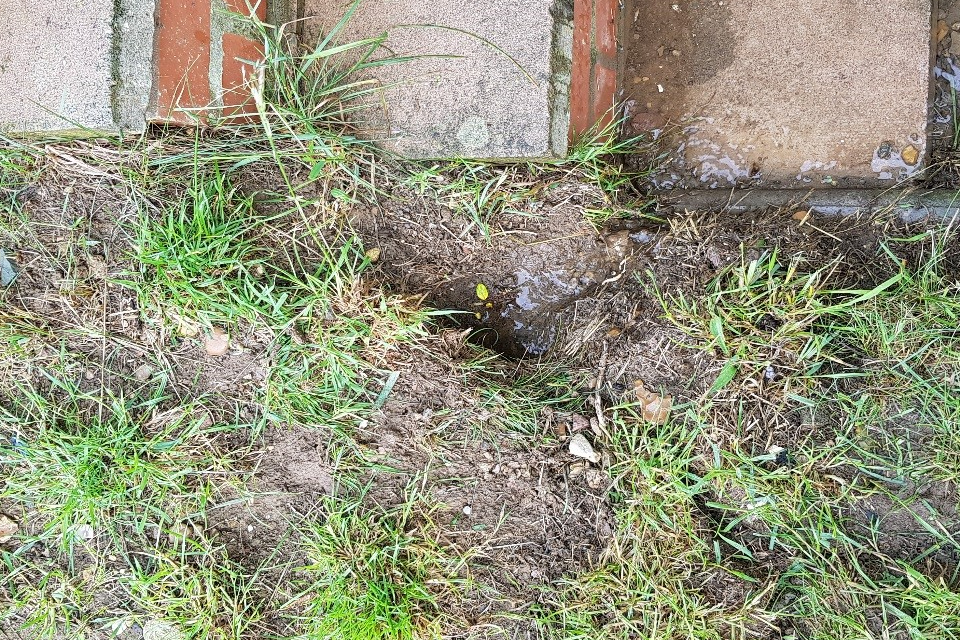
"
The photograph below shows the excavation along the line of the seepage. A yellow hose was inserted through the seepage conduit to identify its location.
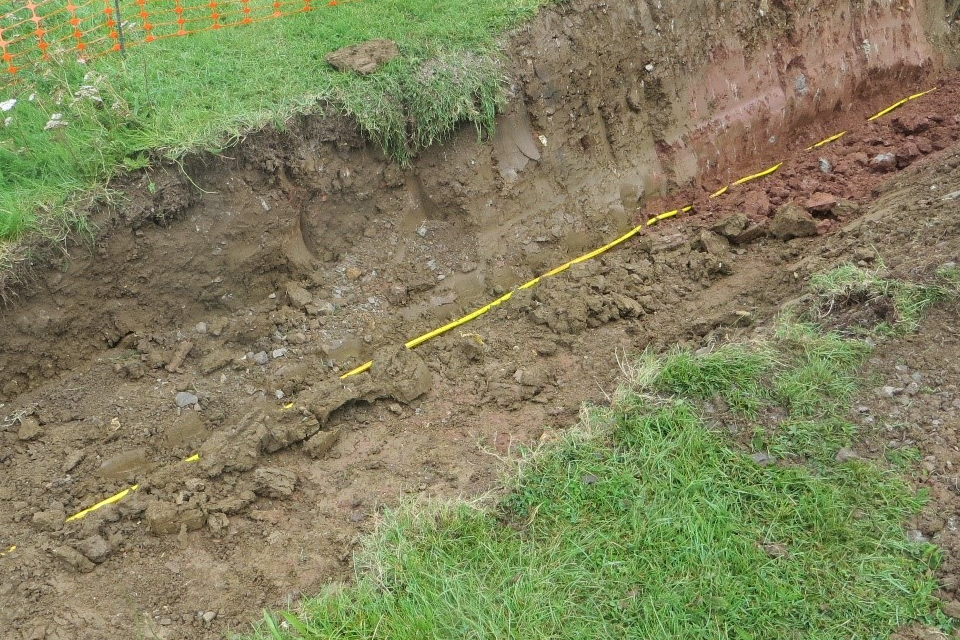
"
The photograph below shows a view of the excavated seepage path.
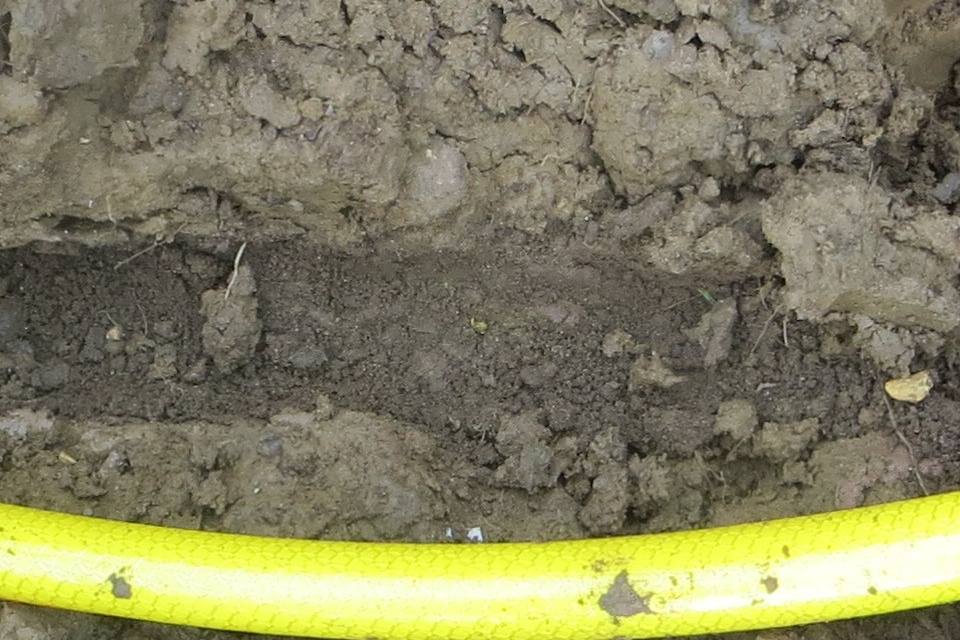
"
Lessons learned
The cause of the seepage path is unclear. Internal erosion is unlikely because the:
- reservoir only fills during flooding
- water pressure acting on the seepage path is low
It is possible that vermin caused it, although there was no evidence of animal activity. The reservoir had been in service for 40 years.
There was no evidence of washed out material near the exit point which could suggest that the erosion had occurred over a long period of time.
The incident highlights how important it is to visit flood storage reservoirs during flood events. This is because defects might not be obvious under normal conditions.
7.3 Incident 459
Dam type: earthfill embankment.
Reservoir legal status: statutory (LRR).
Dam height: 34 metres.
Incident type: embankment deformation.
Incident severity: 3.
This incident occurred at an earthfill embankment dam within a cascade of reservoirs built 160 years ago.
During construction, 2 pipes had been pulled apart due to initial embankment spreading. This was where they passed through the clay core. The damaged pipes were re-lined at the time, and a clay blanket added to the upstream face. Work was also undertaken in the 1990s to increase the distance between the top water level and the top of the dam. This is known as freeboard.
The dam continued to settle (subside) due to the foundation conditions. Before the incident in 2019, quarterly crest settlement surveys had been undertaken. These showed settlement rates over 10mm per year.
As a result of these trends, the undertakers increased the frequency of settlement monitoring. They also investigated potential seepage paths. Water in the reservoir was not allowed to exceed 4m below top water level. The undertakers declared an incident when dirty water discharged near the original outlet pipes.
The undertaker reduced the reservoir water level by a further 2m. They further improved monitoring and surveillance and undertook more geophysical surveys. This was to identify the condition of the embankment and find the most likely seepage routes. It is believed that there was a failure in the clay blanket on the upstream face, approximately 7m below top water level.
Until repairs can be undertaken, increased monitoring and surveillance is occurring:
- at the downstream toe of the embankment, for discharge
- along the crest of the bank for settlement and any change in pore water pressure
Storage at the upstream reservoir is being held down to provide flood protection. The undertaker is continuing to investigate the dam.
Lessons learned
The incident highlights how long-standing issues at dams can escalate quickly.
The dam suffered deterioration during construction, affecting the original outlet pipes. They had been re-lined during construction and grouted in the 1990s. Since then, they had continued to cause concern. More deformation of the embankment had occurred possibly due to internal erosion.
It is not known whether seepage past the clay blanket caused erosion by continued embankment spreading. Raising the dam crest in the 1990s increased embankment loading. This could also have contributed to the incident.
The incident shows the value and importance of regular monitoring and surveillance. This is particularly important when changes in the dam or seepage is identified.
7.4 Incident 460
Dam type: earthfill embankment.
Reservoir legal status: non-statutory (SRR).
Dam height: 1.5 metres.
Incident type: internal erosion.
Incident severity: 1.
This incident occurred at a non-statutory reservoir. A low embankment breached during a period of heavy rainfall. Leakage where the breach occurred had been noted over the past 20 years. No remedial work had been carried out.
The Environment Agency attended the site with a QCE. However, the reservoir had breached before they arrived. The breach was approximately 2.5m wide and the depth of water lost was approximately 0.6m. The damage associated with the breach was minor.
The photographs below show views of the reservoir breach.

"
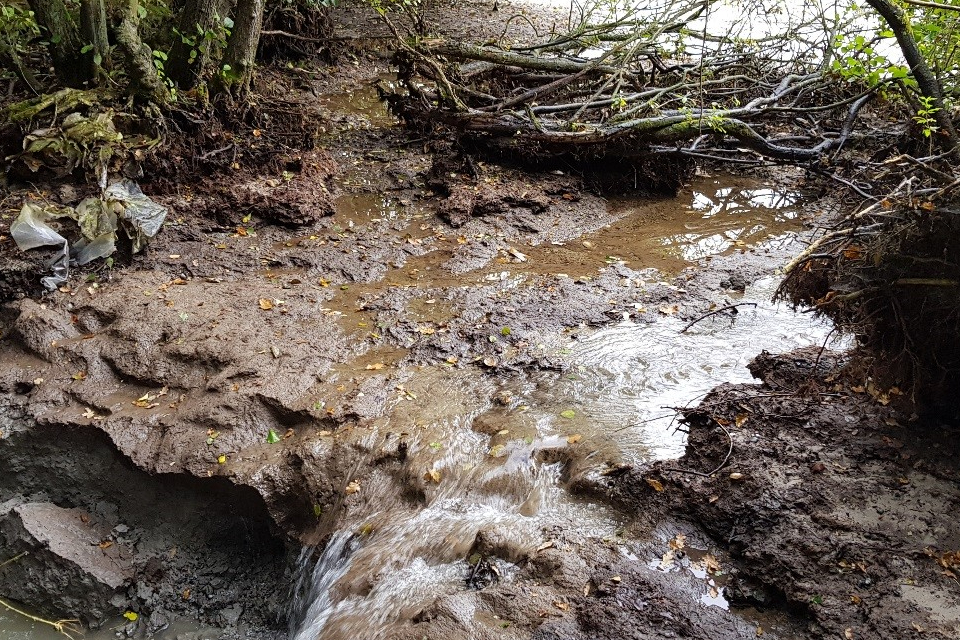
"
Lessons learned
The reports of previous leakage suggest internal erosion was the cause, rather than flood overtopping. It is possible that leakage had been occurring along the roots of the tree that had fallen into the breach. The rate of erosion may have increased during the flood event.
The incident highlights the need to make repairs to defects in embankments on time. Any defective areas awaiting repair should be kept under close surveillance during flood events.
8. 2020 incidents
This section provides details on incidents that occurred in 2020.
8.1 Incident 461
Dam type: earthfill embankment.
Reservoir legal status: statutory (LRR).
Dam height: 6.5 metres.
Incident type: internal erosion.
Incident severity: 3.
This incident occurred at the dam which was the subject of incident 434 (reported in the 2017 annual report). In 2017, a void appeared on the left bank of the reservoir, attributed to tree removal. It formed a seepage path past the left wall of the earthfill embankment dam. The undertaker carried out some temporary repairs. These involved the injection of foamed concrete into the voids. In 2018, an inspecting engineer carried out an inspection under Section 10 of the act. That report recommended permanent repairs. These had been designed and were due to start in April 2020.
In February 2020, a new leak was identified at the side of the cascade spillway structure. It flowed at approximately 1 litre per second. At the time, the undertakers limited the reservoir level following the advice of an inspecting engineer. They opened the reservoir penstock and operated 3 temporary siphons. They improved the plastic sheeting and sandbags on the approach channel, which had been put there in 2017. The undertakers reconstructed the approach channel in April 2020 with a cut-off tied into the core of the embankment. A cut-off is an impermeable barrier built into the dam which prevents seepage. There were voids in the cascade structure caused by seepage water. The undertakers injected further resin grout into the cascade structure to fill these.
Lessons learned
This incident highlights the importance of repairing seepage paths as soon as possible, especially if it is difficult to reduce the water level acting on the seepage path. In this case, the undertaker had placed some plastic sheeting over the area of the seepage path. They also temporarily injected the voids. It was not practicable to reduce the water level. As a result, a new seepage path formed close to the original seepage path. This caused the potential to cause further internal erosion. When waiting for permanent repairs, undertakers must consider adapting monitoring and surveillance regimes for the period of increased risk.
8.2 Incident 462
Dam type: earthfill embankment.
Reservoir legal status: statutory (LRR).
Dam height: 5.5 metres.
Incident type: uncontrolled flow through valve.
Incident severity: 3.
This incident occurred at an impounding reservoir.
A 1 metre by 1 metre penstock gate within an outlet culvert failed in the open position during an exercise. Upstream isolation was not possible. This meant uncontrolled flow from the reservoir was passing through the culvert. The undertaker attempted to insert a stop gate in front of the culvert, but it was unsuccessful. They inserted 1-tonne bags of aggregate upstream of the culvert inlet, and this stemmed the flow. This was 2 days after the incident started. They then installed a temporary dam (‘portadam’-type) over the following 2 days. This allowed safe access into the culvert for inspection.
They found that the coupling for the valve extension spindle had failed above the penstock frame. During the repairs, a new stop gate was installed. This will allow future upstream isolation.
The photograph below shows the ‘portadam’ used to isolate the culvert from the reservoir.
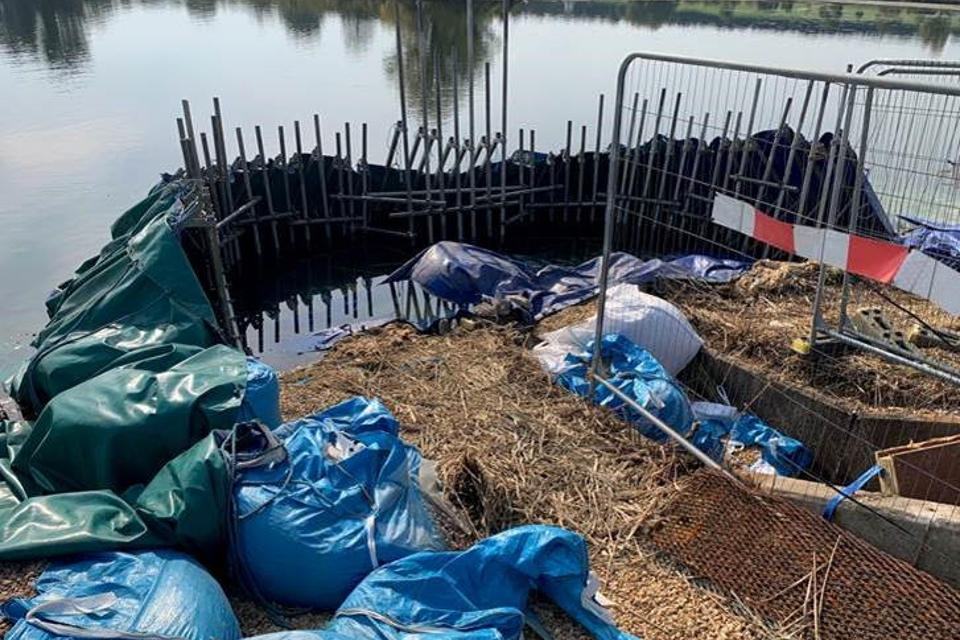
"
Lessons learned
This incident highlights the importance of design. Engineers and designers should include quick and effective access for inspection and repair at the design stage. In this case it was not possible to isolate flow from the culvert entrance. This meant accessing the penstock in the culvert was not possible. Sometimes, the original design does not provide safe access for inspection and repair. In cases such as these, engineers should consider retrofitting suitable facilities. Improvement works like this should, however, be planned activities rather than reactive.
8.3 Incident 463
Dam type: earthfill embankment.
Reservoir legal status: statutory (LRR).
Dam height: 4 metres.
Incident type: leak by pipe or culvert.
Incident severity: 3.
This incident occurred at a non-impounding reservoir. This is where a dam forms all sides of the reservoir. An internal brick retaining wall and earthfill surrounding embankment forms the dam.
Water was observed leaking from the base of the bank on the downstream face. The leakage was on the line of a 610mm diameter cast iron inlet main. This was installed within the embankment in 1950. Fine material was being washed out of the embankment on the line of the leakage. The undertakers stopped pumped inflow to the reservoir from the nearby river immediately.
Draw-off siphons were used to reduce the reservoir water level. These are pipes which use gravity to drain the reservoir over the dam and release the water downstream. The undertakers repaired the inlet main immediately. They found that the leakage came from a joint in the pipe where the coupling bolts in a joint collar had corroded. They repaired this joint. The supervising engineer advised improving the surveillance routine.
The photo below shows the repair of the pipe joint using an encapsulation collar.

"
Lessons learned
This incident highlights the risk associated with pipes through embankments. This is especially the case with pressurised flow in the pipe. Surveillance is particularly important where such pipes penetrate earthfill embankments.
8.4 Incident 464
Dam type: earthfill embankment.
Reservoir legal status: statutory (LRR).
Dam height: 4 metres.
Incident type: other.
Incident severity: 3.
During a flood event, the outlet control penstocks malfunctioned. They closed more quickly than intended and failed to open again. The system had operated correctly on previous occasions and during testing.
The water level control system did not release water from the reservoir as it was designed to do. The undertakers operated the penstocks manually, which released the reservoir. They monitored downstream water levels whilst doing this, so no damage to the dam occurred.
Lessons learned
The undertakers checked the control system after the incident. They compared it to the onsite operation and maintenance manual. The settings for the penstock controls were incorrect. It was assumed they had been incorrectly applied following a dry test of the equipment.
This incident highlights the need to ensure that adequate controls and training is provided to operations staff. This will mitigate the risk of human error. In this case, telemetry and CCTV links alerted the control room. This enabled the incident to be quickly identified and resolved.
9. Analysis of reported incidents
Every 5 years, the Environment Agency reports detailed statistics. The last time this was undertaken was in 2015. The numbers reported here differ from those reported in 2015. This is because regulation of reservoirs in England, Scotland and Wales was devolved in 2016.
Natural Resources Wales regulate reservoirs in Wales. The Scottish Environment Protection Agency regulates Scottish reservoirs. The data shown in this report has been filtered to show only English reservoir incident data.
9.1 Severity and number of reported incidents
The Environment Agency provides data on the number and severity of incidents reported to us between 2004 and 2020 below.
We have only included incidents where there is enough information to assign an incident level. In 2013, it became a legal requirement for undertakers to report any incident which occurs at an LRR.
Although not legally required, a reservoir construction or inspecting engineer should assign a dam category to a LRR as best practice. The category the engineer assigns depends on potential consequences of a dam breach. The dam category assigned is based on Institution of Civil Engineers’ guidance and takes a risk-based approach to reservoir design and inspections.
- category A dam - where a breach could endanger lives in a community
- category B dam - where a breach could endanger lives not in a community or could result in extensive damage
- category C dam - where a breach would pose negligible risk to life and cause limited damage
- category D dam - special cases where no loss of life can be foreseen as a result of a breach and very limited additional flood damage would be caused
- ‘not assigned’ - in some cases, engineers have not assigned a dam category yet to some non-impounding and service reservoirs
- SRRs reservoirs do not have dam categories assigned
Table 1: Number of incidents reported between 2004 and 2020
| Incidents reported | 2020 | 2004 to 2019 |
|---|---|---|
| Total number of incidents | 4 | 104 |
| Incidents at LRRs (statutory) | 4 | 79 |
| Incidents at SRRs (non-statutory) | 0 | 25 |
Table 2: Number of incidents by severity level 2004-2020
| Year | Incident level 1 | Incident level 2 | Incident level 3 |
|---|---|---|---|
| 2020 | 0 | 0 | 4 |
| 2004 to 2019 | 4 | 28 | 72 |
Table 3: Incident severity level 2004-2020
| Year | Incident Level 1 | Incident Level 2 | Incident Level 3 | Total |
|---|---|---|---|---|
| 2004 | 0 | 1 | 0 | 1 |
| 2005 | 0 | 2 | 0 | 2 |
| 2006 | 1 | 0 | 6 | 7 |
| 2007 | 0 | 5 | 10 | 15 |
| 2008 | 0 | 2 | 5 | 7 |
| 2009 | 0 | 2 | 1 | 3 |
| 2010 | 0 | 1 | 2 | 3 |
| 2011 | 0 | 2 | 1 | 3 |
| 2012 | 1 | 6 | 10 | 17 |
| 2013 | 1 | 1 | 1 | 3 |
| 2014 | 0 | 2 | 6 | 8 |
| 2015 | 0 | 1 | 2 | 3 |
| 2016 | 0 | 0 | 7 | 7 |
| 2017 | 0 | 0 | 9 | 9 |
| 2018 | 0 | 2 | 5 | 7 |
| 2019 | 1 | 1 | 7 | 9 |
| 2020 | 0 | 0 | 4 | 4 |
| Totals | 4 | 28 | 76 | 108 |
Table 4: Incidents by dam category 2004-2020
| Dam category | 2004-2020 |
|---|---|
| A | 37 |
| B | 14 |
| C | 7 |
| D | 3 |
| Unknown | 20 |
| Not Applicable | 27 |
9.2 Threats and mechanisms of deterioration
We analyse each of the incidents reported to us to determine the threat to the dam. We also analyse the likely method by which the dam has deteriorated (mechanism of deterioration). Threats to dams can be divided into internal and external threats. Internal threats are:
- instability associated with internal erosion of an embankment dam
-
slope instability associated with slip of an embankment dam
- instability associated with earth or construction works next to the reservoir
- instability of the dam foundation
- material deterioration (for example, corrosion)
- vegetation (for example, tree roots)
External threats are:
- inflow – flood
- inflow – direct rainfall
- inflow – failure of an upstream reservoir
- seismic event
- snow or ice
- aircraft strike
- vandalism
- wind (wave generation or tree damage)
- human error, animals and mining
A summary of the threats and mechanisms of deterioration for each of the incidents reported can be seen below.
Table 5: Number of cases of each internal threat 2004-2020
| Type of internal threat | Number of cases |
|---|---|
| Embankment stability | 44 |
| Stability due to works next to the reservoir | 8 |
| Abutment stability | 0 |
| Foundation stability | 1 |
| Material deterioration | 7 |
| Vegetation | 2 |
| Other | 6 |
Table 6: Number of cases of each external threat 2004-2020
| Type of external threat | Number of cases |
|---|---|
| Inflow flood | 25 |
| Inflow direct rainfall | 0 |
| Snow, ice | 0 |
| Mining | 2 |
| Wind damage (trees) | 0 |
| Wind or wave damage | 3 |
| Animals | 2 |
| Vandalism | 0 |
| Human error | 4 |
| Other | 4 |
Table 7: Number of cases of each mechanism of deterioration 2004-2020
| Mechanism of deterioration type | Number of cases |
|---|---|
| Damage to safety critical structures | 4 |
| Deterioration of upstream protection | 1 |
| Erosion by overtopping | 21 |
| Erosion from localised run-off | 2 |
| Fill deterioration | 8 |
| Foundation deterioration | 1 |
| Hydraulic fracture relating to internal erosion | 0 |
| Increased hydraulic loading | 1 |
| Internal erosion - adjacent to works next to the reservoir | 16 |
| Internal erosion (other) | 23 |
| Not known | 5 |
| Other | 8 |
| Pipework or culvert deterioration | 6 |
| Pore water pressure increase mass movement | 3 |
| Settlement or deformation | 2 |
| equipment deterioration (vales or gates) | 5 |
| Structures deterioration | 1 |
| Wind damage (trees) | 1 |
9.3 Types of lessons learned
When we record incidents on our database, we classify the types of lessons learned. These are summarised below.
Table 8: Number of cases of each lesson identified (2004-2020)
| Type of lesson identified | Number of cases |
|---|---|
| Operational | 9 |
| Physical current condition (deterioration of the design condition) | 23 |
| Physical features intrinsic (inadequacy of the design) | 39 |
| Surveillance | 15 |
| Other | 14 |
| Not known | 5 |
| None | 3 |
The next report containing detailed statistics on reservoir incidents will be in 2025. Until then, we will continue to report final information received on incident which occur at LRRs in England.

